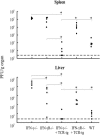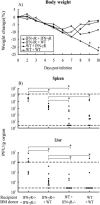Impaired virus control and severe CD8+ T-cell-mediated immunopathology in chimeric mice deficient in gamma interferon receptor expression on both parenchymal and hematopoietic cells
- PMID: 16014969
- PMCID: PMC1181549
- DOI: 10.1128/JVI.79.15.10073-10076.2005
Impaired virus control and severe CD8+ T-cell-mediated immunopathology in chimeric mice deficient in gamma interferon receptor expression on both parenchymal and hematopoietic cells
Abstract
Bone marrow chimeras were used to determine the cellular target(s) for the antiviral activity of gamma interferon (IFN-gamma). By transfusing such mice with high numbers of naive virus-specific CD8(+) T cells, a system was created in which the majority of virus-specific CD8(+) T cells would be capable of responding to IFN-gamma, but expression of the relevant receptor on non-T cells could be experimentally controlled. Only when the IFN-gamma receptor is absent on both radioresistant parenchymal and bone marrow-derived cells will chimeric mice challenged with a highly invasive, noncytolytic virus completely lack the ability to control the infection and develop severe wasting disease. Further, the study shows that IFN-gamma receptor expression on parenchymal cells in the viscera is more important for virus control than IFN-gamma receptor expression on bone marrow-derived cells.
Figures



Similar articles
-
Compromised virus control and augmented perforin-mediated immunopathology in IFN-gamma-deficient mice infected with lymphocytic choriomeningitis virus.J Immunol. 1999 Dec 1;163(11):6114-22. J Immunol. 1999. PMID: 10570301
-
Antigens expressed by myelinating glia cells induce peripheral cross-tolerance of endogenous CD8+ T cells.Eur J Immunol. 2009 Jun;39(6):1505-15. doi: 10.1002/eji.200839019. Eur J Immunol. 2009. PMID: 19462379
-
Immunopathological basis of lymphocytic choriomeningitis virus-induced chorioretinitis and keratitis.J Virol. 2009 Jan;83(1):159-66. doi: 10.1128/JVI.01211-08. Epub 2008 Oct 22. J Virol. 2009. PMID: 18945766 Free PMC article.
-
CD8beta knockout mice mount normal anti-viral CD8+ T cell responses--but why?Int Immunol. 2009 Feb;21(2):123-35. doi: 10.1093/intimm/dxn130. Epub 2008 Dec 15. Int Immunol. 2009. PMID: 19088062
-
Immunometabolism of infections.Nat Rev Immunol. 2020 Feb;20(2):79-80. doi: 10.1038/s41577-019-0266-9. Nat Rev Immunol. 2020. PMID: 31892735 Review. No abstract available.
Cited by
-
Early resolution of herpes simplex virus type 2 infection of the murine genital tract involves stimulation of genital parenchymal cells by gamma interferon.J Virol. 2007 Jan;81(1):423-6. doi: 10.1128/JVI.01455-06. Epub 2006 Oct 25. J Virol. 2007. PMID: 17065206 Free PMC article.
-
Interferon gamma modulation of disease manifestation and the local antibody response to alphavirus encephalomyelitis.J Gen Virol. 2016 Nov;97(11):2908-2925. doi: 10.1099/jgv.0.000613. Epub 2016 Sep 22. J Gen Virol. 2016. PMID: 27667782 Free PMC article.
-
Interferon-gamma negatively regulates Th17-mediated immunopathology during mouse hepatitis virus infection.J Mol Med (Berl). 2011 Apr;89(4):399-409. doi: 10.1007/s00109-010-0711-5. Epub 2010 Dec 30. J Mol Med (Berl). 2011. PMID: 21191565 Free PMC article.
References
-
- Battegay, M., S. Cooper, A. Althage, J. Banziger, H. Hengartner, and R. M. Zinkernagel. 1991. Quantification of lymphocytic choriomeningitis virus with an immunological focus assay in 24- or 96-well plates. J. Virol. Methods 33:191-198. - PubMed
-
- Christensen, J. E., J. P. Christensen, N. N. Kristensen, N. J. Hansen, A. Stryhn, and A. R. Thomsen. 2002. Role of CD28 co-stimulation in generation and maintenance of virus-specific T cells. Int. Immunol. 14:701-711. - PubMed
-
- Christensen, J. E., D. Wodarz, J. P. Christensen, and A. R. Thomsen. 2004. Perforin and IFN-gamma do not significantly regulate the virus-specific CD8+ T cell response in the absence of antiviral effector activity. Eur. J. Immunol. 34:1389-1394. - PubMed
Publication types
MeSH terms
Substances
LinkOut - more resources
Full Text Sources
Molecular Biology Databases
Research Materials

